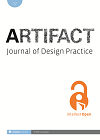-
oa Between yarns and electrons: A method for designing electromagnetic expressions in woven smart textiles
- Source: Artifact, Volume 9, Issue 1-2, Dec 2022, p. 23.1 - 23.25
-
- 14 Feb 2022
- 21 Sep 2022
- 23 Jan 2023
Abstract
The design of woven smart textiles presents a discrepancy of scale where the designer works at the level of structural textile design while facets of the material express at scales beyond one’s senses. Without appropriate methods to address these unknown (or hidden) material dimensions, certain expressional domains of the textile are closed off from textile design possibilities. The aim of the research has been to narrow the gap that presents when one designs simultaneously at the scale of textile structure and electron flow in yarns. It does this by detailing a method for sensing, visualizing, and discussing expressions of electromagnetism in woven smart textiles. Based on experimental research, a method of textile surface scanning is proposed to produce a visualization of the textile’s electromagnetic field. The woven textile samples observed through this method reveal an unknown textural quality that exists within the electron flow – an electromagnetic texture, which emerges at the intersection of woven design and electromagnetic domain variables. The research further contributes to the definition of specific design variables such as: field strength and diffusion expanding the practice of woven smart textile design to the electromagnetic domain.



